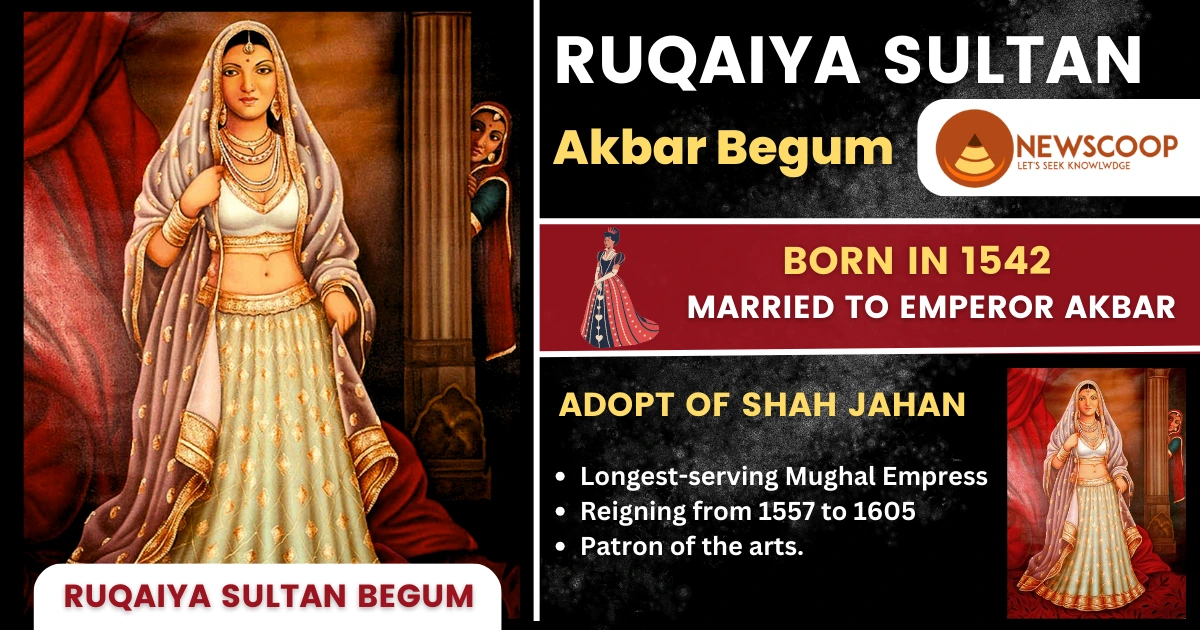Ruqaiya Sultan Begum: The First Wife of Akbar
Ruqaiya Sultan Begum, often referred to simply as Ruqaiya Begum, was a prominent figure in the Mughal Empire during the 16th century. She was not only a trusted confidante of the emperors but also played a significant role in shaping the cultural and political landscape of the era.
In this article, we explore the life, accomplishments, and enduring legacy of Ruqaiya Sultan Begum. A pivotal figure in the Mughal Empire, her influence extended beyond the court, leaving an indelible mark on culture and philanthropy. Her story is a testament to women’s power in shaping empires.
| Full Name | Ruqaiya Sultan Begum |
| Born | 1542 |
| Father | Shaikh Bahauddin Kamboh |
| Spouse | Emperor Akbar (Mughal Empire) |
| Marriage to Akbar | 1557 (at the age of 15) |
| Children | No biological children |
| Religious Affiliation | Sunni Muslim |
| Notable Titles | Empress of the Mughal Empire |
| Death | Died at the age of 84, in 1626 |
Table of Contents
Who was Ruqaiya Sultan Begum?
Ruqaiya Sultan Begum, born in 1542, was a prominent figure in the Mughal Empire during the 16th century. She was the first wife of Emperor Akbar the Great, making her the empress consort of the Mughal Empire. Further, Ruqaiya was a member of the Mughal royal family, being the daughter of Hindal Mirza, who was the youngest son of Emperor Babur.
Real Photo of Ruqaiya Begum
In this portrait of Ruqaiya Begum, you can see her calm and beautiful face, with soft features and kind, thoughtful eyes. Her royal clothes are detailed with jewels and fine fabric, showing her high status.

She stands gracefully, and her expression shows both strength and elegance. This picture perfectly captures the beauty and dignity of the first wife of Emperor Akbar.
History of Ruqaiya Begum
Ruqaiya Sultan Begum was born in 1542 into the esteemed Mughal lineage as the daughter of Hindal Mirza, the youngest son of Emperor Babur, and Dildar Begum. This privileged ancestry granted her a prominent position within the imperial court from the very beginning of her life.
Her early years were spent amidst the opulence and grandeur of the Mughal dynasty, where she was immersed in the rich cultural and political tapestry of the era. This upbringing would go on to shape her into the influential figure she would become in the annals of Mughal history.
Marriage to Akbar
Ruqaiya Sultan Begum’s marriage to Akbar was a significant event in Mughal history. After the passing of her father, Hindal Mirza, in battle, Humayun, deeply saddened by the loss, arranged for Ruqaiya, then just nine years old, to marry Akbar. This strategic alliance was forged in Kabul, Afghanistan, shortly after Akbar’s appointment as viceroy in Ghazni.
Following Humayun’s demise in 1556, Ruqaiya, along with other female members of the imperial family, resided in Kabul amidst a backdrop of political uncertainty. She later joined Akbar in Punjab in 1557, following the victory over Sikandar Shah, pledging allegiance to the Mughal army.
Accompanied by her mother-in-law, Hamida Banu Begum, and her aunt, Gulbadan Begum, Ruqaiya’s journey to India marked a significant chapter in her life.
The union between Ruqaiya and Akbar was solemnized near Jalandhar, Punjab when both were just fourteen years old. Simultaneously, Ruqaiya’s first cousin, the 18-year-old Salima Sultan Begum, wed Bairam Khan, Akbar’s esteemed regent.
After a four-month sojourn in Punjab, the family embarked on a journey to Delhi, marking the establishment of the Mughal dynasty’s presence in India.
Adoption of Shah Jahan
Ruqaiya Sultan Begum, having ascended to the role of Mughal Empress in 1556, faced the challenge of remaining childless throughout her marriage with Akbar. However, her pivotal role in the upbringing of Akbar’s beloved grandson, Prince Khurram, who would later become the illustrious Emperor Shah Jahan, reshaped her status within the imperial harem.
In 1592, when Khurram was just six days old, Akbar made the momentous decision to entrust his care to Ruqaiya, fulfilling her heartfelt desire to nurture a future Mughal emperor.
Ruqaiya not only provided for Khurram’s physical well-being but also took charge of his education, cementing a strong and affectionate bond between them. Akbar, too, regarded Khurram as his own, acknowledging Ruqaiya’s unparalleled devotion.
At the age of 14, Khurram returned to the care of his biological mother, Jagat Gosain, after Akbar’s passing in 1605. Despite this transition, Ruqaiya continued to play a significant role in Khurram’s life.
She also extended her maternal care to Khurram’s first daughter, Parhez Banu Begum, born to his first wife, Kandahari Begum, leaving an indelible mark on the early years of the future Emperor Shah Jahan’s family.
Achievements of Ruqaiya Begum
Ruqaiya Sultan Begum, while not a ruler in her own right, played a significant role in the Mughal Empire and left a lasting impact on its history. Here are some of her key achievements:
- Longest-serving Mughal Empress, reigning from 1557 to 1605.
- Prominent patron of the arts, supporting miniature painting, poetry, and music.
- Active involvement in philanthropy, funding hospitals, schools, and charitable institutions.
- Adoption of Shah Jahan, who later became a renowned Mughal Emperor.
- Skilled diplomat, mediating political conflicts within the Mughal court.
- Featured prominently in historical novels and portrayed in popular TV serials.
- Enduring legacy in Mughal culture, influencing art and philanthropy.
Also read: Rajput Policy of Akbar
Ruqaiya Sultan Begum’s Death
In 1626, at the age of 84, Ruqaiya Sultan Begum passed away in Agra. For the last two decades of her life, she lived apart from her husband.
Her final resting place is in the Gardens of Babur (Bagh-e-Babur) in Kabul, Afghanistan, at the fifteenth level. This location held special significance as her grandfather, Babur, and her father, Hindal Mirza, were also interred there.
Her foster son, Shah Jahan, deeply moved by her enduring influence and love, commissioned the construction of a tomb in her honor, a fitting tribute to a remarkable woman who had left an indelible mark on Mughal history.
Thank You!

